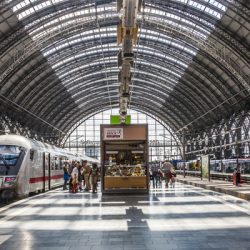The changing landscape of Europe’s railway industry

The first commercial steam trains started rolling in early 19th century in England. Since then the railway industry evolved at a rapid pace so much so that in the second half of the 20th century, the term “bullet train” was widely used for high-speed locomotives.
The 20th and 21st century saw many locomotive manufacturing companies emerging in US and Europe. In Asia, China was a bit late in joining the major league players. However, rapid industrialization of China and its aim for dominating the global industry and commerce resulted in the creation and rise of CRRC Corporation Limited (CRRC), a locomotive manufacturer. Headquartered in Beijing, CRRC Corporation Limited (CRRC) has 46 wholly-owned & majority-owned subsidiaries and over 180,000 employees. (source: CRRC website) Following suit, Chinese “rail operators” emerged. Very shortly they started bidding for UK and European rail transport projects. Recently, China’s state-owned Guangshen Railway Co Ltd and MTR Corp Ltd, which runs Hong Kong’s rail network, were shortlisted for “UK High Speed 2- HS2” project. HS2 is a high-speed railway project that will directly link London, Birmingham, the East Midlands, Leeds and Manchester. The final decision has yet to be taken. (source: www.chinadaily.com)
Chinese ambition for global dominance can be understood by looking at its One-Belt-One-Road (OBOR) project. In January, 2018 state-run China Railway Corporation successfully completed its first railway journey from China to the UK. The train arrived in London at Barking’s Eurohub freight terminal. It was a tremendous achievement. On its way back the train covered over 12,000-kilometers (7,500 miles), making it the second-longest route in the world after the China-Madrid link. London is the 15th city to be linked to this new freight network. The train, known as ‘East Wind’ after former Chinese communist leader Mao Zedong’s saying “The East Wind shall prevail over the West,” carried 88 shipping containers on its return journey back to China. It passed through France, Belgium, Germany, Poland, Belarus, Russia and Kazakhstan during its 20-day trip and reached its destination, an eastern Chinese city of Yiwu. (source: Deutsche Welle)
It is a fact that major projects of China in foreign countries are funded by its resourceful state. This is why competing with China is difficult for US and European public companies. However, this time Europe’s locomotive manufacturers made a swift and surprising move to counter the rising threat of Chinese dominance. Siemens (Germany) and Alstom (France) agreed to merge their rail operations. Siemens runs its railway division under the name “Siemens Mobility”. This potential merger will result in a railway giant in Europe. Though the deal is yet to be approved by EU regulatory authorities, it is a very positive step for gaining market share of the EU transportation sector. The two rail groups have combined sales of €15.3 billion ($18 billion) and earnings before interest and tax of €1.2 billion. The merger, which is expected to be completed by the end of the year, subject to approval, will create the world’s No. 2 firm for building train carriages. (source: Deutsche Welle)
It is pertinent to mention here that China’s CRRC, which has annual revenue of about €28 billion, will still lead the railway industry.
Notable terms of “potential merger” between Siemens and Alstom are: (source: DW)
- The merged company will be named “Siemens Alstom” and will be headquartered in Paris, France.
- It will “not” be a sub-division of Siemens.
- It will be listed on the French stock market.
- The CEO of Alstom will be the CEO of the merged entity.
- Siemens will control 50% of Alstom immediately, but will be blocked from taking more than 50.5% stake for the next four years.
Labor unions
Labor Unions have a strong influence on the German and French transportation sector. Both, Siemens and Alstom labor unions fear job cuts and closures and therefore have threatened to block the deal. They already have registered their “combined” protests. Alstom employs 32,800 people worldwide. Siemens Mobility has 28,800 staff members. (source: www.thelocal.fr)
Latest developments
Both, Siemens and Alstom have “recently” clinched lucrative European deals while operating as separate entities. This will bolster their combined revenue once the merger is approved.
Siemens has entered into an agreement (August 17, 2018) with Austrian railway operator OeBB to supply trains worth up to € 1.5 billion ($1.71 billion). Production will start in April next year (2019). (source: Reuters)
Alstom secured a €2.7 billion order (July 26, 2018) from France’s SNCF for a new version of the high-speed TGV train. (source: Nasdaq)
The future of the railway industry in Europe
It is expected that Germany will amend its Foreign Trade Ordinance this year to ensure that “non-EU investors” are restricted from acquiring more than 25% of any critical infrastructure or business that is of vital importance to its national security policy. Germany, being the powerhouse of the EU economy, is expected to pass the new regulations while taking its EU partners in confidence. Once these new trade regulations get implemented, it is very likely that Siemens/Alstom merger will go-ahead. The EU’s transportation sector will grow once China’s influence is tamed.


